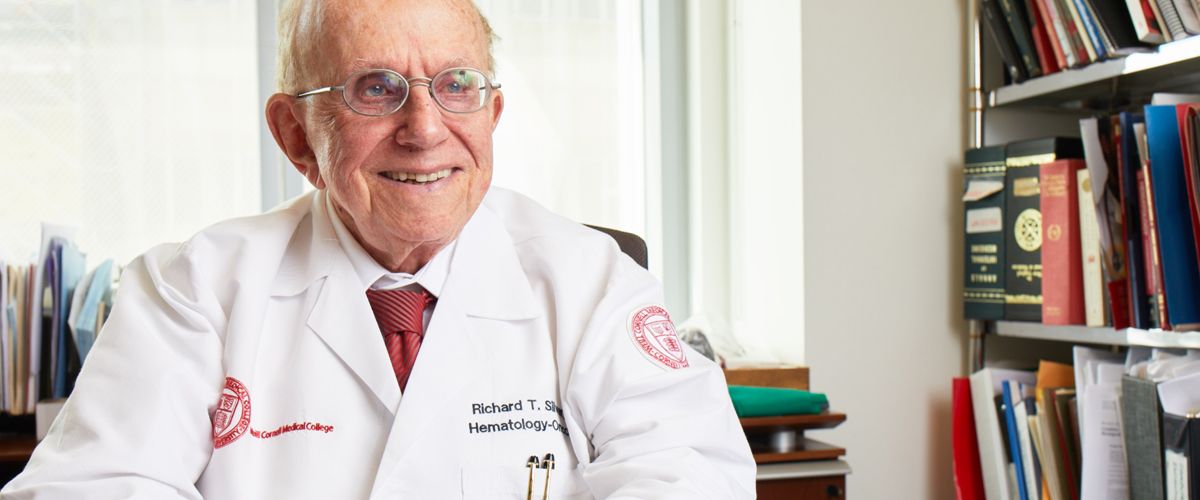Inside NYP: Dr. Richard Silver

I wasn’t sure that I wanted to become a physician. I was actually an excellent clarinet player. I went to the High School of Music & Art in New York City, and I played next to a young man named Stanley Drucker, who was always better than me. He joined the New York Philharmonic, remained there for 60 years and became the first clarinetist, so I know I made the right decision — I never wanted to be a second clarinetist.
To me, life is often shaped by happenstance. I’ve been working in medicine since 1954. When I was an intern at the New York Hospital-Cornell Medical Center, military service was mandatory because of the Korean War, and there was a “doctor draft.” Because I’d been on duty, I was late getting down to the draft board. All of the slots in the Army, Navy, and Air Force were filled for the following July.
So I went to Washington, D.C., and tried again to enlist without success. I was told, however, that serving in the Commissioned Corps of the U.S. Public Health Service would fulfill service obligations. The General Medicine Branch of the National Cancer Institute was looking for young physicians to serve as interns, so I signed up, even though it meant that I had to be an intern once again; moreover, the clinical cancer program at that time was considered the gulag of all the institutes. However, I was on night call only once a month, so it was pretty painless compared to what I had been through previously. During that time, I became very interested in leukemia, although I always had thought of becoming a cardiologist. This led me to complete a residency in hematology at the New York Hospital-Cornell Medical Center by 1958. I spent a year in Salvador, Brazil, where I was a Visiting Fulbright Professor, helping to establish a residency program at the Federal University of Bahia in collaboration with Cornell (the affiliation still exists). To paraphrase Robert Frost, the path less traveled is the most interesting. I have been here ever since.
The reason I’m still working today is because I find a great deal of interest and stimulation in the work that I’m doing. It’s very creative, full of new discoveries and excitement, and it keeps my mind particularly active. I believe the academic atmosphere at the hospital and the medical college is second to none. And so, I have continued to publish, lecture, and teach. Recently, I’ve been part of a huge advancement in leukemia treatment involving an oral drug called imatinib (Gleevec®). This is a cancer pill that has caused sustained remissions in chronic myeloid leukemia (CML), with the life span of patients who respond to treatment (the great majority) approaching normal.
Chronic myeloid leukemia is a disease I’ve been interested in since I was a resident. In those days, it was fatal in nearly all cases within three to five years. In the late 1990s, it was recognized that imatinib blocked the molecular abnormality characteristic of the disease. It was the patients who were going to die from this illness who demanded that Novartis, the pharmaceutical company that produced the pill, introduce the drug into clinical trials.
Novartis approached certain key figures in the U.S. who had clinical experience in CML, which included me, and we at NewYork-Presbyterian/Weill Cornell Medical Center, participated in the first clinical trials of the drug. And it worked! Of the patients we treated with imatinib in 1999 and 2000, 80 percent are still alive. Other drugs closely related to imatinib have now been developed.
This is my 63rd year working professionally in medicine. What’s my goal? I’d like to cure cancer in general and leukemia especially, but I don’t think I’m going to do either! However, as long as I think I am productive and making a meaningful contribution, I’ll continue to work as long as people will have me. Rather than do Japanese crossword puzzles or take a course in ancient Assyrian literature to keep my mind active, I’d rather do something I’m good at.
This interview first appeared on the NYP site, Health Matters. Read the original here.


